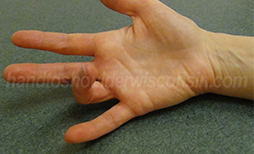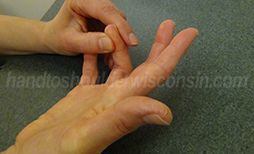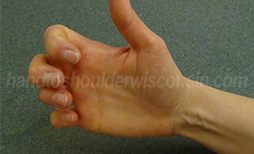Have you been diagnosed with or believe you have trigger finger, or stenosing tenosynovitis? Learn more from the dedicated orthopedic specialists at the Hand to Shoulder Center of Wisconsin. Our team is comprised of orthopedic doctors and specially trained occupational and physical therapists and staff that have extensive experience with trigger finger treatment, including surgery and exercises. Learn more about trigger finger treatments and how the orthopedic team of specialists at Hand to Shoulder Center of Wisconsin can help.
What Is Trigger Finger?
Stenosing tenosynovitis, more commonly known as trigger finger, is the catching or locking of a finger or thumb in a bent (flexed) position. In mild cases, the finger or thumb will get “stuck” with straightening, requiring extra effort to open the hand, or the assistance of the other hand to fully straighten the involved digit. Clicking and/or popping sensations may be heard or felt as the finger straightens. Trigger finger can affect one or more fingers or thumbs, although it is more commonly known to affect the little, ring finger or thumb area of the hand. It is more prevalent in the right hand but does affect the left hand as well. Trigger finger is usually encountered in adults due to overuse, but children can also be affected and at times, infants can be born with this condition.
Symptoms and Causes of Trigger Finger
Initial symptoms usually start with tenderness and swelling at the base of the finger surrounding the joint. Finger stiffness along with a clicking or popping sensation is often felt when the finger is flexed toward the palm of the hand and extended. In mild cases the clicking and popping sensation is more of an annoyance with no pain. However, in more severe case, the clicking and popping can elevate into a bent, locked position (Fig. 1-2) with severe pain when extended.
 Figure 1: Locked position – Trigger Finger |
 Figure 2: Unlocking Trigger Finger |
The cause of trigger finger is often unknown, however, it is the result of inflammation to the tendons inside the finger. Tendons are rigid, rope-like structures that assist your muscles in moving and bending your fingers. Tendons attach muscle to bone and are held in place by an array of ligaments called pulleys. The pulleys stretch over the tendons forming a “tunnel-like” sheath. Tenosynovium is a slippery coating that provides lubrication to the sheath and tendon for ease of movement. When inflammation develops, the tendon can thicken (swell) promoting irritation and blockage in the flow of tenosynovium in the tunnel-like sheath. Nodules form in the tendon from the irritation and blockage. When bending the finger, the nodule passes under the pulley and becomes stuck or locked. The nodule is unable to move back through the pulley and the finger locks in the bent “trigger” position.
Diagnosis and Treatment of Trigger Finger
The orthopedic physicians at Hand to Shoulder Center of Wisconsin are highly experienced in hand and upper extremity injuries and conditions. A thorough examination is conducted and all prior hand, wrist, and arm injuries and conditions are explored. Upon evaluation, diagnosis of a “trigger” finger can easily be confirmed if the finger is in a locked position. A clicking or snapping sensation can also be felt when extended.

Figure 3: Hook fisting
In mild cases of trigger finger, rest, splinting to limit finger motion, instruction in “hook fisting” (Fig. 3) which promotes tendon glide without the nodule getting “stuck” and modification of activities to reduce or eliminate repetitive gripping are recommended. Non-steroidal anti-inflammatory medications (NSAID’s) and/or applying ice for short periods of time may alleviate swelling. If the digit does not respond to rest and splinting a cortisone injection may also be recommended to reduce inflammation.
In more severe cases, a trigger finger release, also known as open trigger release surgery, may be recommended. Surgery is conducted under local anesthetic and can be performed as an in-office or outpatient surgery. Surgery locations include an in-office procedure at Hand to Shoulder Center of Wisconsin, Woodland Surgery Center, or one of the three Fox Valley hospital locations.
A small incision (cut) is made at the base of the finger and the tunnel-like sheath is widened allowing the tendon to glide smoothly. In some cases, trigger finger exercises from a physical or occupational therapist may be suggested for follow-up care after surgery to aid in regaining range of motion and to strengthen and stretch the muscles in the hand.
